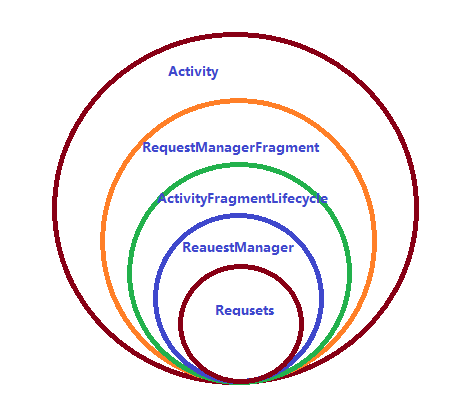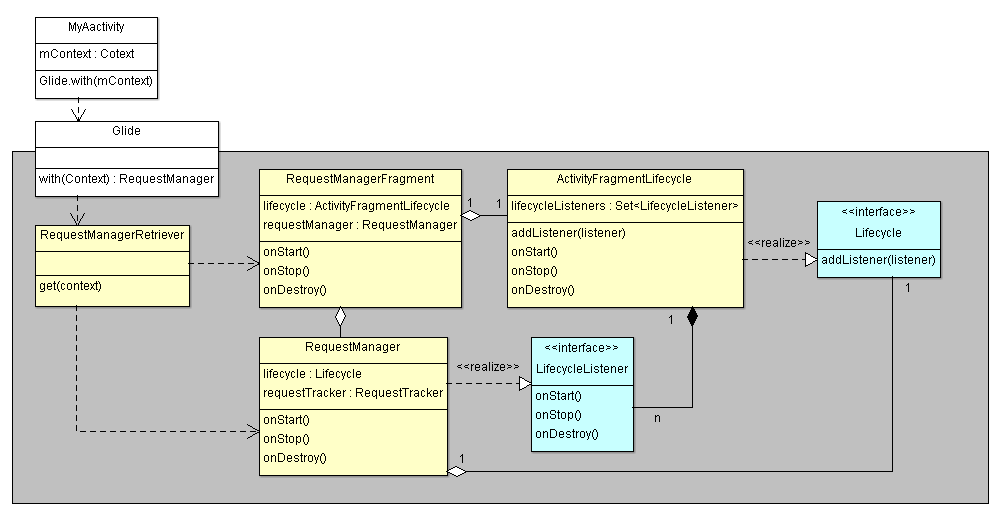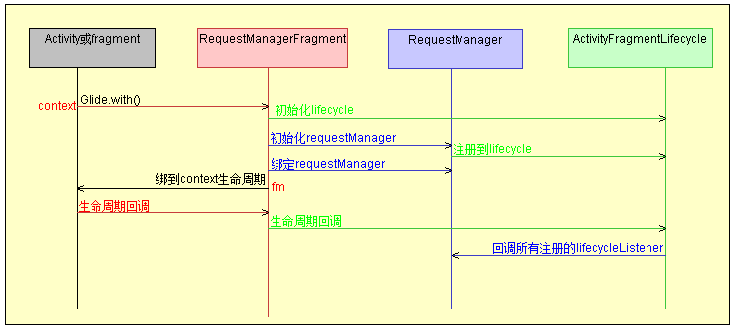前言
近期研究了一下Glide的图片加载框架,在这里和大家分享一下。由于代码研读有限,难免有错误的地方,了解的童鞋还望指正。如果这篇文章对大家学习Glide有帮助,还望大家多多转载。学习小组QQ群: 193765960。
本篇是Glide框架及源码解析的第一篇,更多文章敬请关注后续文章。版权归作者所有,如有转发,请注明文章出处:https://xiaodanchen.github.io/
相关文章:
跟着源码学设计:Glide框架及源码解析(一)
跟着源码学设计:Glide框架及源码解析(二)
跟着源码学设计:Glide框架及源码解析(三)
跟着源码学设计:Glide框架及源码解析(四)
跟着源码学设计:Glide框架及源码解析(五)
1. Glide 简介
Glide是一个性能优良的第三方网络图片加载框架,在节省内存和快速流畅加载方面具有较好体现。究其内部机制,发现其优良性能得益于以下几点:
- 与使用环境生命周期相绑定:RequestManagerFragment & SupportRequestManagerFragment
- 内存的三级缓存池:LruMemoryResources, ActiveResources, BitmapPool
- 内存复用机制:BitmapPool
更多的关于Glide的介绍网上资料很多,在这里不再赘述,下文中将针对Glide的内部机制展开说明。
1.1 为什么要绑定生命周期(有什么优点)?
- 可以实现网络请求根据生命周期而暂停、执行、恢复、释放等
- 可以实现资源比如图片的自动释放
- 降低了内存的压力
- 降低了内存泄漏的风险
1.2 绑定原理
- 原理的知识基础:FragmentManager(简称fm)中的所有fragment(通过fm.add()添加进来)都与fm所处的context生命周期绑定。例如:我们的activity中的fragment的生命周期自动通过activity的fm和activity的生命周期绑定。
- Glide定义了RequestManagerFragment 和 SupportRequestManagerFragment两种fragment。该两类Fragment不具有任何的界面和其他功能,通过入口传入的context获取到的fm绑定生命周期到context上。
- Glide内部的生命周期绑定机制进一步通过基于xxxxRequestManagerFragment 的生命周期接口的回调实现。
2. Glide生命周期回调示意图

3. Glide生命周期绑定机制类图

3.1 RequestManagerRetriever(单例模式)
- 根据context获取fm;
- 获取xxxxRequestManagerFragment实例
- 获取RequestManager实例
- 相互绑定xxxxRequestManagerFragment和RequestManager
- xxxxRequestManagerFragment绑定到context生命周期
|
|
3.2 xxxxRequestManagerFragment(绑定context的生命周期)
- 内部绑定一个RequestManager对象;
- 内部绑定一个ActivityFragmentLifecycle对象
- 在生命周期的回调中调用ActivityFragmentLifecycle的相应生命周期方法
- RequestManager通过注册到ActivityFragmentLifecycle的lifecycleListeners集合实现生命周期绑定
|
|
3.3 ActivityFragmentLifecycle
- 管理同一个xxxxRequestManagerFragment分支下的所有LifecycleListener(具有生命周期)
- 被xxxxRequestManagerFragment生命周期接口回调
- 遍历回调所有LifecycleListener生命周期接口
|
|
3.4 RequestManager
- RequestManager被绑定于xxxxRequestManagerFragment
- RequestManager实现了LifecycleListener接口
- RequestManager注册给xxxxRequestManagerFragment的ActivityFragmentLifecycle
|
|
4. Glide生命周期绑定机制时序图

(本篇是Glide框架及源码解析的第一篇,更多文章敬请关注后续文章。版权归作者所有,如有转发,请注明文章出处:原文链接)
